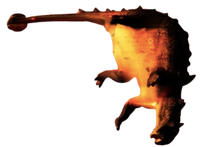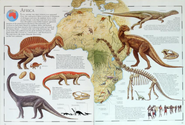
| Dicraeosaurus Temporal range: Late Cretaceous (155-150 Mya) | |
|---|---|

| |
| Restoration of Dicraeosaurus hansemanni | |
| Scientific classification | |
| Kingdom: | Animalia |
| Phylum: | Chordata |
| clade: | †Diplodocoidea |
| Order: | †Saurischia |
| Suborder: | †Sauropodomorpha |
| Family: | †Dicraeosauridae |
| Genus: | †Dicraeosaurus Janensch, 1914 |
| Species: | †D. hansemanni |
| Binomial name | |
| Dicraeosaurus hansemanni Janensch, 1914 | |
Dicraeosaurus (Gr. δικραιος, dikraios "bifurcated, double-headed" + Gr. σαυρος, sauros "lizard") is a genus of small diplodocoid sauropod dinosaur. It was named for the spines on the back of the neck. The first fossil was described by paleontologist Werner Janensch in 1914.
Description[]
Unlike most diplodocoids, Dicraeosaurus had a large head with a relatively short and wide neck. The neck contained 12 unusually short vertebrae, so it could probably browse vegetation only from ground level to a height of about 3 metres (9.8 ft).[1] It also lacked the whiplash tail that other diplodocids had. It was smaller, at only reached 12 metres (39 ft) in length. It gets its name, which means two-forked lizard, from the spines that came from the vertebrae. They were not straight as in some members of the family. Each one was “Y” shaped, like a fork. These spines also provided muscle attachment points.[2]
Paleoecology[]
Dicraeosaurus lived in the Late Jurassic. It was herbivorous; however, it didn’t compete with other dinosaurs for vegetation. Fossils have been discovered in the rocks of Tendaguru Hill in Tanzania. The rocks also yield fossils of Giraffatitan and Kentrosaurus. As there was a distinct difference in size between these animals, they would probably have browsed for vegetation at different levels, allowing them to co-exist without significant competition.[2]
Classification[]
The following cladogram follows an analysis by Sereno et al. in 2007.[3]
| Diplodocoidea |
| |||||||||||||||||||||||||||||||||||||||||||||||||||||||||||||||||||||
Gallery[]
References[]
- ↑ Benton, Michael J. (2012). Prehistoric Life. Edinburgh, Scotland: Dorling Kindersley. p. 270. ISBN 978-0-7566-9910-9.
- ↑ 2.0 2.1 Palmer, D., ed (1999). The Marshall Illustrated Encyclopedia of Dinosaurs and Prehistoric Animals. London: Marshall Editions. p. 132. ISBN 1-84028-152-9.
- ↑ Sereno PC, Wilson JA, Witmer LM, Whitlock JA, Maga A, et al. (2007) Structural Extremes in a Cretaceous Dinosaur. PLoS ONE 2(11): e1230.















